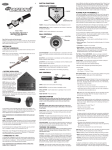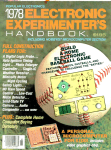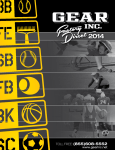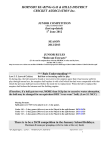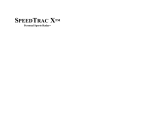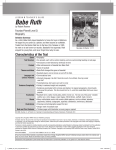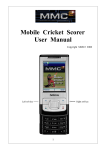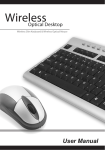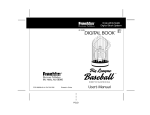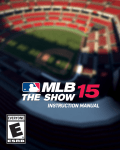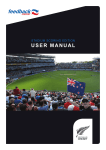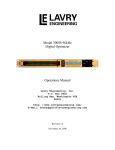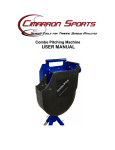Download the Zooka zs740 manual
Transcript
Important Safety Information Read all instructions before operating the Zooka Sports Pitching Machine. These instructions were written to ensure your safety and to protect the equipment. DANGER: To reduce the risk of electrical shock, always unplug the unit from its power source before cleaning or performing any maintenance tasks. WARNING: To reduce the risk of injury to persons, take the following precautions: • Never leave the pitching machine unattended. The pitching machine is specifically designed to throw baseballs at high speed. It should be used with appropriate care. PAGE 2 • Prevent unauthorized use. Do not reveal the ACCESS CODE to children or permit them or other unauthorized persons to operate the machine. • Always turn the machine OFF when leaving it unattended or before performing maintenance tasks. • Before loading a ball, check that the line-of-fire is clear. • Never reach into the machine or put your face in front of the barrel when the unit is turned ON. DANGER: You can be seriously injured if you are struck by a ball at high speed! • Make sure that batters always wear batting helmets. • Use only the approved pitching balls. (See page 13.) • Never put foreign objects into the barrel or serious injury to the operator or bystanders can result. • Use the pitching machine for its intended use as described in this manual. Do not use accessory equipment that is not recommended by the manufacturer—such attachments may cause injuries. • Important control points (for example, ON/OFF button, pitch/ pan knobs) are colored orange. • Do not try to recharge the unit if it has a damaged cord or plug. If the unit has been damaged, return it to a service center for repair. Table of Contents Important Safety Information ...................... 2 5 Speed Spread Settings Adjusting the Spread Setting Pitching with Speed Spread Essential Maintenance ................................. 4 Charging the Battery Cleaning the Barrel Cleaning the Optical Sensors Throwing Changeups ................................. 14 14 14 15 4 4 4 6 Practice Drills ............................................ 16 1 Unpack ........................................................ 5 7 Storing the Machine .................................. 17 2 Charge the Battery ...................................... 6 3 Setup in the Field......................................... 7 Safety Requirements Setting Up the Tripod Attaching the Machine Determining the Pitch Angle Adjusting the Pan Angle 4 7 7 8 9 9 Pitching ..................................................... 10 Turning the Machine ON Entering your Access Code Setting the Power Level Emergency Shutdown Load and Throw the Ball Selecting the Ball Type Checking Battery Status 10 10 11 11 12 13 13 Taking the Machine Off the Tripod Long Term Storage 17 17 8 Changing the Access Code ........................ 18 9 Avoiding Problems ..................................... 19 Error Codes Troubleshooting 10 20 21 Maintenance ............................................. 25 Cleaning the Machine Replacing the Battery Disposing of the Battery Battery Charger Power Cord Replacing the Throwing Cup Optional Accessories Obtaining Service 25 26 29 29 30 30 30 Zooka Warranty ................... inside back cover PAGE 3 Essential Maintenance These simple maintenance procedures will greatly extend the lifetime of your machine and assure optimum performance. DIAGRAM 1 CHARGING THE BATTERY Grit transferred from the balls into the barrel will shorten the life of the cup and barrel. You must recharge the battery promptly after every use or its life will be severely shortened. Clean the cup and barrel after each use as described on page 25. Charging the Battery To prevent shortening the life of the battery, keep it fully charged by consistently: recharging the battery promptly after each use as described on page 6. storing the pitching machine in a cool, dry place (preferably below 72°F) Even if it’s only partially discharged, always recharge the battery to its full capacity. PAGE 4 Cleaning the Barrel During long-term storage, the battery should remain permanently connected to the charger and the charger plugged into a power source. A microprocessor, inside the machine, monitors the battery and maintains a full charge. Help keep the machine clean by knocking excess dirt and debris off balls before loading them into the machine. Cleaning the Optical Sensors Optical sensors detect the ball and measure its speed. The sensors are located on either side of the barrel just inside the ball scoop. Clean them with a moist cotton swab after every few practice sessions, as described on page 26. 1 Unpack DIAGRAM 2 ZOOKA SPORTS PITCHING MACHINE AND CONTENTS Handle The Zooka Sports Pitching Machine is inspected before shipment so that it will arrive in good operating condition. It is shipped with the following parts: Zooka Sports Pitching Machine POR TA B L LL E BU PEN Display Keypad DO WN OF F ON / Barrel EN TER UP Tripod Battery charger Ball scoop PITCHING MACHINE Owner’s Manual Check the contents of your package upon receipt. Refer to the Diagram 2. If any items are missing or the unit has been damaged during shipment, please contact Zooka Sports Customer Service at 425.861.0111 or visit our web site at www.zooka.com. NOTE: Save the shipping container. LED (flashes just before ball is thrown) Orange adjustment knob (adjusts tilt angle and clamps machine to tripod) Orange adjustment knob (adjusts the pan setting left to right) TRIPOD (FOLDED) Black clamping knob (secures the tripod legs) CHARGER Mounting bracket PAGE 5 2 Charge the Battery Charge the battery prior to using the machine. Always charge the battery promptly after each use, even if it is only partially discharged. Proper charging is extremely important for long battery life. The high-capacity battery that powers your machine is a sealed lead acid battery. If properly maintained, the battery will last 5 to 10 years. If stored in a discharged condition for an extended period, it can fail in less than a month. While in storage, the charger can be connected to the machine without overcharging the battery. Use the charger provided by Zooka Sports. Other chargers may damage the unit and void the limited warranty. IMPORTANT: Always charge the battery in an area at room temperature or cooler. Do not charge or store the battery where temperatures exceed 100°F. To charge the INTERNAL battery: 1. Turn the machine OFF. 2. Make sure that the rear panel switch is depressed toward the INTERNAL battery position. DIAGRAM 5 CONNECTING THE CHARGER 3. Plug the end of the charger cable into the rear panel. See Diagram 5. 4. Plug the charger into a 100 to 130 VAC outlet. The machine will turn PAGE 6 on and begin charging. Initially ‘--’ will appear on the display for 5 minutes while the battery condition is analyzed. 5. After the battery condition is determined, the percent of battery charge appears on the display along with the word CHARGING. As the charging progresses, the display indicates the degree of charge in 5% increments. 6. The battery recharges to 100% within 12 to 24 hours. When the battery is fully charged, the charger enters a monitoring mode and the word CHARGING turns off. If the charge drops below 75%, a new charge cycle begins and restores the battery to a full charge. NOTE: During the charge cycle, it is normal for the battery to remain at 95% for a few hours. The machine can be used prior to reaching 100%, but periodically it should be fully charged to ensure maximum battery life. 3 Setup in the Field This section describes how to set up the tripod in the field and attach the pitching machine. Safety requirements, that you need to follow, are also provided. Safety Requirements Setting Up the Tripod 1. Pick up the tripod by its legs. Check that the mounting bracket is in-line with the top of the lower bracket. Tighten its orange knob securely. See Diagram 6. • Never leave the pitching machine unattended unless it is turned OFF. 2. Loosen the black knob that clamps the tripod’s legs. Turn the knob counterclockwise. • Make sure that batters wear batting helmets. DIAGRAM 6 SETTING UP THE TRIPOD • Keep the area in front of the pitching machine clear. • Always be aware of safety. Adult supervision is required to set up and use the pitching machine. • Check the tripod for stability and verify that all adjustment knobs are secure. • With the machine assembled, throw test pitches to check the aim and speed of the pitch before pitching to a batter. Mounting bracket Orange knob (Make sure it is firmly tightened.) Black clamping knob 3. Grasp an individual leg of the tripod and spread the other legs fully (into a triangular pattern). DIAGRAM 7 POSITIONING THE TRIPOD Home plate Orange knob (Make sure it is firmly tightened prior to setting up the tripod.) Mounting bracket Black clamping knob Tripod rear leg 5. Set the tripod upright. If the legs wobble, loosen the black knob and reset the legs. Firmly tighten the black knob until the legs are secured. NOTE: When the tripod is set up in the pitching area, the tripod should be positioned with two legs forward and the rear leg pointing toward second base. See Diagram 7. To ensure stability, press tripod legs into the ground. 4. Secure the legs by tightening the black knob clockwise. PAGE 7 Attaching the Machine Look at the bottom of the pitching machine to understand how the machine and tripod fit together. See Diagram 8. The large cutout on the underside of the case fits over the top of the tripod. The clamping bolt on the machine slides into the slotted tab on the tripod. Take the following steps to assemble the machine onto the tripod: 1. Check that the tripod mounting bracket is aligned as shown in Diagram 6 and that both tripod knobs are securely tightened. DIAGRAM 10 TIGHTENING THE CLAMPING KNOB POR ENTE TA B L LL E BU PEN R DOWN OFF ON / UP Orange clamping knob DIAGRAM 9 ATTACHING THE MACHINE DIAGRAM 8 VIEWING THE CUTOUT Loosen the orange knob before placing machine onto the tripod. Mounting bracket Slot on bracket 2. Loosen the orange knob on the machine so that it is easy to mount the machine onto the bracket. 3. With the barrel of the machine fairly level, place the front edge of the cutout against the front of the tripod’s mounting bracket. Lower the machine into place. See Diagram 9. PAGE 8 NOTE: It may help to wiggle the machine slightly to seat the clamping bolt in the slot on the tripod’s mounting bracket. 4. Tighten the orange clamping knob clockwise to secure the machine onto the tripod’s mounting bracket. See Diagram 10. Determining the Pitch Angle The power level setting (which affects speed) and pitching angle determine the height at which the pitch crosses the plate. If you increase the speed of the pitch, you’ll need to flatten the pitching angle of the machine. A flat angle on the machine affects how well the ball seats itself into the throwing cup, so greater care may be needed when loading the ball. IMPORTANT: At speeds above 55 mph, it may be helpful to move the machine 10 to 15 feet further away from home plate so that you can increase the pitching angle. To help identify the appropriate pitch angle, locate the label on the tripod’s mounting bracket. See Diagram 11. To change the pitch angle, take the following steps: 1. Hold the machine’s handle while loosening the orange knob on the right side of the case one full turn. DIAGRAM 11 CHANGING THE PITCH ANGLE Handle PO ENT DOW RT AB LE BU LL PE N Orange knob adjusts Pitch Angle. ER N UP ON / OFF Mounting bracket Adjusting the Pan Angle The orange knob on the tripod’s mounting bracket adjusts the left-right “pan” movement. To change the pan angle, take the following steps: DIAGRAM 12 ADJUSTING THE PAN ANGLE Label 2. To move the unit up or down, apply pressure to the back of the handle. 3. Align the base of the housing to the appropriate pitch angle on the label. The MPH marks on the left approximate the pitch angle for various speeds (30 - 60 MPH) so that the ball passes within the strike zone. If the machine is placed between 46 and 60 feet from home plate, each tick mark on the right side of the label approximates a 1 foot change in the “arrival height” at the plate. 4. Tighten the orange knob securely. Handle Orange knob adjusts Pan Angle 1. Hold the machine’s handle while loosening the orange knob on the tripod’s mounting bracket one full turn. See Diagram 12. 2. Move the machine left or right to the desired position. 3. Retighten the orange knob securely. PAGE 9 4 Pitching Entering Your Access Code Turning the Machine On Once the pitching machine is set up, make sure that the battery selector switch on the rear panel is set to INTERNAL. Press and hold the ON button until you hear a beep. Then, release the button. The machine turns ON and ACCESS CODE 1 appears in the display. DIAGRAM 13 TURNING THE MACHINE ON ON OFF UP D O W N E N T E R NOTE: To turn the machine OFF, press the ON/OFF button. The machine beeps twice and turns OFF. PAGE 10 A 4-digit number must be entered to activate the pitching mechanism. Entry of this code must begin within a few seconds of turning the machine ON or it will shut down. The ACCESS CODE helps prevent unauthorized use of the pitching machine. IMPORTANT: Once you enter the access code, the machine will throw a pitch whenever a ball is loaded. To assure safety, do not reveal your Access Code to anyone except responsible adults. Always turn the machine OFF before leaving it unattended. Your pitching machine is shipped with the ACCESS CODE preset to 1919. It is strongly recommended that you change the code to a 4-digit number that you can easily remember. Refer to “Changing the Access Code” on page 18. After turning the machine ON, the display prompts you for the first two digits of the ACCESS CODE. DIAGRAM 14 ENTERING THE ACCESS CODE ACCESS CODE 1 ON OFF UP D O W N ACCESS CODE E N T E R 1 ON OFF UP D O W N E N T E R 1. Press the ▲ key to change the first digit. See Diagram 14. 2. Use the ▼ key to adjust the second digit. 3. When the two digits of the code are shown correctly, press ENTER. The display prompts you for the last 2 digits of your code. Repeat steps 1 - 3 above for the last two digits. If you entered a correct ACCESS CODE, the display advances to PITCH mode. Otherwise, the unit displays “Error 14” and turns OFF. Setting the Power Level The power level directly affects the speed of the pitch. The higher the power level setting, the faster the pitch. The power level setting appears on the display when the machine is ready to pitch. The default power setting is 40%, which will throw real baseballs at approximately 35 mph. Use the ▲▼ buttons to adjust the power level setting from 1% to 100%. IMPORTANT: Changes to the power level settings can only occur when the compressor is not running. Pressing any button when the compressor is running, activates an emergency shut down. To adjust the pitch height in the strike zone, slightly increase or decrease the power level. If the power level is changed significantly, you will need to adjust the pitch angle (elevation). Refer to “Determining the Pitch Angle” on page 9. DIAGRAM 16 ADJUSTING THE POWER LEVEL NOTE: First-time users should start at a low power level to get used to the pitching machine. Pitch a few balls, and then gradually increase the power level as needed. DIAGRAM 15 PITCH MODE Emergency Shutdown % PITCH ON OFF UP D O W N In an emergency, you can stop a pitch by pushing any button on the keypad while a ball is in the barrel. Every time you use the pitching machine, set aside time to practice aborting pitches so that you will be comfortable doing it if an emergency arises. E N T E R PAGE 11 Load and Throw the Ball DIAGRAM 17 LOADING THE BALL CAUTION: Be Safe! Batters must wear helmets. Keep children away from the pitching machine. Turn the machine off before leaving it unattended. You can be seriously injured if you are struck by a ball thrown from the pitching machine. Loading the ball initiates a throw. The machine pumps up to pressure and throws the ball. Pitch speed in miles per hour (MPH) is displayed after each pitch. The machine repeatedly throws pitches at the same speed until you change the power level setting. The pitching machine can use a number of different types of balls. Typically, balls of different weight or rebound characteristics will be thrown at different speeds and therefore arrive at the plate at different heights. Approved ball types are described on page 13. CAUTION: Always remember to throw a few test pitches to check the aim point and speed of the ball before pitching to the batter. PAGE 12 The machine provides an audible and visual countdown, throws the pitch, and displays the speed in miles per hour (MPH). If you block the optics while loading a ball, the machine will turn OFF. Avoid placing fingers inside the barrel while feeding a ball. To load a ball, take the following steps: 1. Use an approved ball as described in the section titled, “Selecting the Type of Ball” on page 13. 2. Always load the ball while standing to the side of the machine. See Diagram 17. 3. Check that the line-of-fire is clear. 4. Cup a ball in your hand and gently roll it into the barrel. As the ball passes the optical sensors, the compressor is activated and runs for a few seconds (depending upon the power level). ` NOTE: When the ball is rolled in at the proper speed, it seats itself in the cup. A roll that is too fast or too slow may cause the ball to bounce out of the cup. If the ball is not seated in the cup, the pitch is thrown at a slow speed with a hollow sound. Most duds result from rolling the ball in too quickly. 5. To adjust the power level setting for the next pitch, press the ▲▼ buttons. 6. Load another ball to initiate the next pitch. Selecting the Type of Ball To optimize consistency from pitch to pitch, do not mix different ball types in a single pitching sequence. Discard lopsided, oversized, or damaged balls. Machine pitch dimple balls produce the tightest pitching pattern because of their uniformity and symmetry. They are ideal for practice requiring pinpoint placement, such as learning to hit a pitch on the low outside corner, working on batting mechanics, or learning to time faster pitching. They are also very durable. Real baseballs tend to scatter about more in the strike zone because of their seams and non-uniformity. This results in more game-realistic pitching, because the hitter doesn’t know in advance where the pitch will be placed. Low quality baseballs should not be used as they tend to become lopsided and inaccurate with use. Franklin Sponge Rubber baseballs are soft and work well with the machine. These rubber baseballs are somewhat lighter than real baseballs, but are heavy enough for fielding practice and game play. Tennis balls make good practice balls, especially for younger players. They are inexpensive, safer because they are lighter and softer, and produce a tight scatter pattern. The pressureless type, such as those made by Tretorn™, are highly recommended because they are more durable and do not lose their bounce. Safety soft-core balls are produced by several companies. Some brands are accurate in our machine and some are not. Generally, those which deform uniformly when squeezed and which give a true bounce when dropped onto a flat surface are likely to perform better. Visit our website at www.zooka.com for more information on types of balls. Checking Battery Status The battery icon on the display shows the approximate remaining battery capacity. For a more precise measurement, press the ENTER key after any pitch. The display will show the remaining capacity of the battery in 5% increments. The machine automatically reverts to pitching mode after 2 seconds or when a ball is loaded. DIAGRAM 16 VIEWING BATTERY STATUS % BATTERY ON OFF UP D O W N E N T E R PAGE 13 5 Throwing Changeups The Model ZS740 pitching machine can randomly mix changeups, midspeed pitches, and fastballs. These changes in pitch speed vary the location of the pitch in the strike zone. This provides more game-realistic pitching for advanced batters, requiring them to adjust to changes in pitch speed and location. The changeups at higher power settings are awesome! This feature should be used only with more advanced hitters. It is most effective with real baseballs or dimple balls at power settings between 65% and 93%. (Speeds from 45 to 65 mph.) The changeup feature is also useful for a variety of advanced fielding drills to teach fielders to judge and move to line drives and fly balls. Speed Spread Settings Adjusting the Spread Setting The user can adjust the speed spread, and thus the vertical spread of pitches in the strike zone, by setting a spread from 0 to 5. Setting 0 (no spread) is the normal pitching mode. For safety, the machine defaults to setting 0 on power-up. Setting 5 (maximum spread) corresponds to approximately 4 feet of vertical spread at a pitching distance of 60.5 feet, or approximately 2 feet of vertical spread at a pitching distance of 46 feet. Starting from pitching mode, to adjust the spread setting: 1. Press the ENTER key twice within 2 seconds to enter the pitch setup menu. The display will show the present spread setting. DIAGRAM 19 ADJUSTING THE SPREAD SETTING SETUP PITCH ON PAGE 14 OFF UP D O W N E N T E R 2. Adjust the setting shown on the display using the ▲▼ buttons. 3. If no buttons are pushed for 3 seconds, or if the user presses ENTER or loads a ball, the machine advances to pitching mode with the new spread setting in effect. The spread setting may be adjusted at any time between pitches. Pitching with Speed Spread CAUTION: For safety reasons, always change the speed spread back to setting = 0 before adjusting the aim point. When you are satisfied with the aim point, then increase the spread setting to the desired value. Always throw several test pitches before pitching to a batter. Speed spread is intended for advanced batting and fielding practice. Operation of the machine when speed spread is active is exactly the same as with spread = 0, except that while the compressor is running, the display shows 1 (low changeup), 2 (mid-speed), or 3 (high fastball) to advise the operator of the type of pitch which will be thrown. Adjusting the power level, emergency shut-down, speed readout, and all other features operate exactly the same as in the normal pitching mode. PAGE 15 6 Practice Drills Easy set up and battery operation make the Zooka Sports Pitching Machine ideal for a wide variety of batting and fielding practice drills. Its accuracy helps players improve their skills quickly through repetition. CAUTION: Be Safe! Batters must wear helmets. Keep children away from the pitching machine. Turn the machine off before leaving it unattended. You or other people can be killed or seriously injured if struck by a ball thrown from the pitching machine. Tips for Batting Practice Tips for Outfield Practice • For young players, use tennis balls. Tennis balls are inexpensive, softer and quite accurate. • Adjust the pitch angle and power level setting to throw high fly balls or line drives. • For pinpoint accuracy, use machine pitch dimple balls. • Practice “catch on the run” drills. Line the players up on the right field sideline. When the ball is launched, have the first fielder run into right field to make the catch. Launch the next ball and have the next fielder run the same drill. As the players gain skill, increase the distance to be run. Practice variations of this drill having players catch balls while running to the right, left, in, or out. • For beginners, send the pitch right down the middle. Work with players on watching the ball and making contact with it. Synchronize a throwing motion with each pitch, to help with timing. • Have skilled players practice hitting more difficult pitches on the low outside corner or up and in tight. • For more scatter around the strike zone, use real baseballs rather than dimple balls. • Practice “pulling” the ball. • Have fielders practice judging and catching pop-ups and line drives. Keep the pitch speed low until the players gain skill. • Practice hitting outside pitches to the opposite field. • Practice catching line drives to the left and right. • For advanced players, practice hitting changeups. Refer to page 14. • Practice catching short overhead pop-ups. • Practice bunting. PAGE 16 Tips for Infield Practice 7 Storing the Machine IMPORTANT: Before removing the pitching machine from its tripod, check that the orange knobs are tight. Loose knobs, especially the orange knob on the tripod’s mounting bracket, can make it difficult to remove the machine and may cause injury to yourself or the equipment. DIAGRAM 20 LIFTING MACHINE OFF THE TRIPOD Handle Loosen orange clamping knob. Mounting bracket Taking the Machine Off the Tripod Long Term Storage To remove the machine from the tripod: 1. Check that both orange knobs (one on the mounting bracket, one on the machine) are tight. Store the machine in a cool, dry location. To store the machine for over 4 months, the best way to maintain the battery charge is to keep the machine connected to the charger and have it plugged into a power source. The following provides the recommended storage procedures. 1. Clean the barrel, cup and optics as described on page 25. 2. Make certain that the machine is turned OFF. 3. Hold the handle on the top of the machine while loosening the orange knob on the right side of the machine one full turn. See Diagram 20. 4. Lift the machine off the tripod. 5. Recharge the battery, even if it is only partially discharged. You must recharge the battery promptly after every use or its life will be severely shortened. Batteries which are stored in a discharged condition will fail in less than one month. 2. Store the pitching machine in a cool, dry place where temperatures are between -30° to +75°F. 3. Make sure that the rear panel switch is set at the INTERNAL battery position. 4. Attach the charger to the pitching machine and plug it into a power source. Charge the battery (preferably overnight) before using it again. NOTE: If you decide not to leave the pitching machine continuously plugged into a power source, you will need to recharge the battery fully every 4 months. PAGE 17 8 Changing the Access Code The preset code 1919 should be changed to a number that you can remember easily. Any number between 0001 and 9999 is allowed. To change the ACCESS CODE, take the following steps: DIAGRAM 21 CHANGING THE LEFT DIGIT DIAGRAM 22 ENTERING THE FIRST 2 DIGITS ACCESS CODE ACCESS CODE 1 ON OFF 1 UP D O W N E N T E R 1. Turn the pitching machine OFF. 2. Simultaneously press and hold the ON and the ENTER buttons until the unit beeps. 3. Immediately after the beep sounds, press and hold both ▲▼ buttons for about 6 seconds while the display runs through a short diagnostic test. Hold the ▲▼ buttons until the machine beeps twice. NOTE: If you do not hear two beeps, you will have to start over by turning the machine OFF. PAGE 18 ON 4. A prompt for the first 2 digits of your new ACCESS CODE appears on the display. Use the ▲▼ buttons to change the numbers. Entry of the new code must begin within a few seconds or the machine will shut down and you will need to begin again. 5. Press the ▲ key to change the left digit. See Diagram 21. 6. Use the ▼ key to change the right digit. OFF UP D O W N E N T E R 7. When the two digits of the code are displayed, press ENTER. 8. The display prompts you to enter ACCESS CODE 2, the second set of 2 digits. Follow steps 5–7 above. The machine beeps twice which confirms the entry of your new ACCESS CODE. The code appears briefly on the display and then the display advances to PITCH mode. 9. Write down your new ACCESS CODE. 9 Avoiding Problems A few easy steps can be taken before you need to call Customer Service regarding ERROR codes or pitching problems. Write ERROR codes down and follow the instructions given below. One of the first things to do is verify whether a problem exists with the charger or the battery. Charger Battery The charger is operating properly if the machine turns ON when the charger is connected to the machine and plugged into a power source. If the machine remains OFF, then you need to: check that the rear panel battery selector switch is depressed toward the INTERNAL battery position. If the battery is suspect, then you need to: check that the rear panel battery selector switch is depressed toward the INTERNAL battery position. use a volt meter to check whether the charger is defective. Note that most electronic supply stores will do this for you. press the ON button, hold it for a few seconds and then release it after you hear a beep. If the machine does not turn ON, it is most likely a dead or deeply discharged battery. Charge the battery for a full 24 hours. Refer to “Charging the Battery.” If the machine still does not turn ON, the battery may need replacement. check that the internal battery cables have not become disconnected. This requires opening the machine. Refer to the instructions found in “Replacing the Battery.” PAGE 19 Error Codes If an error occurs, the machine displays: Error Code Description 10 11 12 13 Program memory error Low battery voltage Sunlight on optics Blocked optics Call service department at 425.861.0111. Charge battery. (see Section 2) Reposition machine or shade optics. Clear or clean optics. (see Section 10) Push cup back a few inches if it is near the front of the barrel. 14 Incorrect access code 20 Optics blocked while pitching 21 22 30 31 Manual emergency shutdown Battery completely discharged while pitching Incorrect or defective charger No battery or very low battery 32 Battery did not charge fully Enter correct access code or change code. (see Section 8) Clear or clean optics. Avoid placing fingers into barrel while feeding ball. Feed ball faster. Restart machine. Charge battery. Use correct charger—Zooka Part No. 14001. Set rear panel switch to ‘INTERNAL’ position or charge battery. (see Section 2) Disconnect then reconnect charger, this will initiate a new charge cycle. If error continues, replace battery. (see Section 10) If other error codes appear, check with Customer Service at 425.861.0111. PAGE 20 Solution Troubleshooting Solutions to the most commonly-reported pitching machine problems are provided below. Power-related Symptom Machine doesn’t turn ON. Solution Check that the rear panel battery selector switch is depressed at the INTERNAL battery position. Press the ON button, hold it for a few seconds, and then release it after you hear a beep. Recharge or replace the battery. Refer to “Charging the Battery.” Machine turns itself ON. The ON button may have been pressed. Press the button again to turn OFF the machine. The machine is connected to the battery charger. The machine turns ON automatically when the charger is plugged into a power source. Refer to “Charging the Battery” for more information. Machine won’t turn OFF. Check to see if the machine is connected to the battery charger. If it is, the machine is operating correctly. The machine should turn OFF within 10 seconds when you disconnect the charger. If the battery charger is not connected, call Customer Service immediately. Switch the battery selector switch on the rear panel to EXTERNAL and do not use the machine! Keep it away from children. PAGE 21 Troubleshooting - continued Power-related Symptom Machine turns itself OFF. ACCESS CODE-related Symptom I forgot my ACCESS CODE. Pitching-related Symptom The compressor doesn’t start PAGE 22 Solution You may not have used it for over 10 minutes. If the optical sensors or display keypad receive no input for 10 minutes, an automatic shutdown occurs. The optical sensors may be blocked. Clear the optical path. Keep fingers out of the barrel when loading balls. Clean optics. An error may have occurred. Check the display for an ERROR code and write it down. If you can, solve the problem and restart the machine. Otherwise, call Customer Service. Recharge or replace the battery. Refer to “Charging the Battery.” Solution Change the 4-digit ACCESS CODE. Refer to “Changing Your Access Code” on page 18. Solution Clean the optical sensors with a moist cotton swab. Refer to page 26. Check the display. If an ERROR code appears, write it down and refer to page 20. If necessary, turn the machine OFF and start over. Troubleshooting - continued Pitching-related Symptom Some balls do not throw straight. Solution Refer to page 13, “Selecting the type of Ball,” to make sure that the ball is an approved type and size for the pitching machine. Look the ball over. Discard worn or damaged balls. Do not use balls that are irregular in shape or have unusually large seams. Use a clean cloth to wipe dirt off balls prior to using them. Some throws are duds. A hollow sound occurs and the ball’s momentum slows. The ball is not seating properly in the cup. Most duds result from rolling the ball into the barrel too quickly, especially at low pitching angles. First try rolling the ball in more slowly. If that doesn’t work, try rolling the ball in more quickly. Look the ball over. Discard worn or damaged balls. Do not use balls that are irregular in shape or that are too large. For speeds over 50 mph, try moving the machine 10 feet further from the plate and slightly increasing the angle of the pitch. Refer to “Changing the Pitch Angle.” If the pitcher’s mound is raised, place the tripod either behind the mound or in front of the mound to avoid pointing the barrel of the machine downward. Cup comes all or part way out of the barrel Turn OFF the machine. Remove the cup (page 25). Clean the barrel and cup. Replace worn or damaged cups. PAGE 23 Troubleshooting - continued Pitching-related Symptom Speed measurement too high or too low Solution Look the ball over. If the ball is too large or not an approved ball type (refer to page 13), do not use it. Clean the optical sensors. When the sensors are dirty, they cannot properly measure the ball’s speed. Refer to page 25, “Cleaning the Machine.” Turn OFF the machine and wipe the barrel clean. Remove the cup. Refer to page 25. Look the cup over. Clean it if necessary. A dirty cup can stick in the barrel and block the sensors. Replace worn or damaged cups. Charging-related Symptom Fewer than 200 pitches on a charge Solution Check battery status as described on page 13. The battery may not have been fully charged when you began throwing. If necessary, charge the battery. Review and follow the instructions found in the first few paragraphs of “Avoid Problems.” If the battery is not holding a charge you may need to replace it. See “Replacing the Battery.” PAGE 24 10 Maintenance To keep the pitching machine running smoothly, you need to clean the unit and charge the battery after each use. This section describes these and other maintenance tasks, such as obtaining service and replacing the battery. To clean the barrel and cup, take the following steps: 1. Remove the cup from the barrel. Reach into the barrel and grasp the cup in your fingertips. DIAGRAM 24 REMOVING THE CUP 2. Rotate the cup as you pull it out. Pull slowly and steadily. DIAGRAM 23 TIPPING THE BARREL DOWN Cleaning the Machine CAUTION: Unplug the charger and turn OFF the machine before performing any cleaning tasks. ON / OFF UP DOWN ENTE R PO RT AB LE BU LL PE N To pitch successfully, the cup and barrel must be cleaned after each use. Grit and dirt easily transfer from the balls into the barrel and shorten the life of the cup and barrel. NOTE: If the cup is out of reach, position the machine so that the barrel faces down. Gravity helps the cup settle forward. 3. When the cup reaches the ball scoop, you will need to pull the rubber away from the sides of the cup to facilitate removal. 4. Dump any dirt from the barrel and wipe the inside of the cup with a clean, dry cloth. The barrel should be smooth and clean. Deposits or marks on the barrel can be wiped with a clean cloth dampened with isopropyl rubbing alcohol or a mild solution of dishwashing liquid and water. PAGE 25 DIAGRAM 25 REPLACING THE CUP DIAGRAM 26 CLEANING THE OPTICAL SENSORS Replacing the Battery According to current environmental regulations, the pitching machine’s battery contains hazardous materials. If you need to replace it, the battery must be disposed of according to Hazardous Waste Regulations. 5. Wipe off the cup and remove any embedded grit or gummy buildup. If necessary, scrape carefully with a putty knife or other dull blade. Wash the cup in a mild solution of dishwashing liquid and water. 6. Replace the cup and push it back into the barrel. See Diagram 25. The optical sensors that detect the ball and measure its speed are located in the orange plastic recesses on opposite sides of the barrel just inside the ball scoop. Clean the sensors with a moist cotton swab. Cleaning the optical sensors is recommended after every few practice sessions, or more often under unusually dirty conditions. DANGER: Do not drop or open the battery case! The chemical components inside the battery can damage human tissue and the surrounding environment. The machine’s battery is built to last a long time. However, if you find that any of the following consistently occur, you may want to replace the battery. • errors 11, 22, or 31 continually appear on the display after minimal use. • the machine won’t turn ON after fully charging the battery. • the battery display consistently shows a low charge (less than 25%) after minimal use. PAGE 26 DIAGRAM 27 SWITCHING TO EXTERNAL BATTERY Mode Number Seria ZC740 www DIAGRAM 28 REMOVING THE KNOB AND SPACER DIAGRAM 29 REMOVING THE TOP OF THE CASE 4. Hold the machine by its handle and remove the orange knob by rotating it counterclockwise. Set the knob aside. See Diagram 28. 7. Remove the 10 screws with a Phillips head screwdriver. Set the screws aside. Number zooka com EXT. BATTERY / AUTOLOADER CHARGER BATTERY SELECT INTERNAL EXTERNAL To replace the battery, take the following steps. Tools required: Phillips head screwdriver. 1. Turn the power OFF. Make sure that the machine is OFF and disconnected from its charger. 2. Press the switch on the rear panel to EXTERNAL. See Diagram 27. 3. Remove the machine from its tripod. Refer to page 17. 5. Tilt the machine slightly to slide the aluminum spacer off the threaded bolt. 6. Lay the machine on its side so that the case’s 10 mounting screws are accessible. Support it so that the machine remains level. 8. Carefully, open the case. Set it aside. NOTE: When you lift off the top of the case, the rear panel may be pulled from its mounting location. Remember to replace it properly, prior to replacing the screws. NOTE: The threaded bolt, that is attached to the inside of the case, lifts out when you remove the top of the case. PAGE 27 DIAGRAM 30 REMOVING/REPLACING THE BATTERY DIAGRAM 31 REPLACING THE CONNECTORS DIAGRAM 32 RESETTING THE REAR PANEL - + Notches in rear panel 9. Remove the battery connectors. Gently, slide both wire connectors off of the old battery. Pull on the connectors, not on the wires. IMPORTANT: Do not force the removal. Gently wiggle the connector side to side while pulling on it. 10. Lift the “old” battery out of it’s bracket and set it aside. See Diagram 30. Replace it with the new battery. PAGE 28 11. Replace the wire connectors. Connect the red wire to the + terminal. Connect the black wire to the - terminal. NOTE: The battery is marked with + and - on the top and bottom of the battery. It is essential that the wire connections are replaced correctly, otherwise the machine will not operate properly. IMPORTANT: Check that the rear panel is properly positioned prior to replacing the case. Do not tighten the screws until the rear plate is secure. The two notches in the rear panel align it properly. See Diagram 32. DIAGRAM 33 APPLYING PRESSURE TO THE CASE 14. Perform an operational check by pressing the rear panel battery select switch to INTERNAL, and then take the following steps. a. Set the machine upright and turn it ON. 12. Replace the top of the case and align the mounting holes. If it is properly aligned, you will hear a click as you apply gentle pressure to the top of the case. 13. Replace the 10 screws and tighten them gently. IMPORTANT: Do not apply so much pressure or tighten the screws so severely that you cause hairline fractures in the case. b. The display should prompt you for your ACCESS CODE. If the display is blank, recheck the battery connections by performing steps 1 through 9 and steps 11 through 14 until you receive the prompt. Disposing of the Battery The high-capacity battery is a sealed lead acid battery. Though this type of battery is non-spillable and can be shipped, it is also considered hazardous waste and must be disposed of according to the Hazardous Waste Laws that govern the area where you live. Please be considerate of the environment and educate yourself on the Hazardous Waste Laws in your area. Dispose of the battery properly. c. Turn the machine OFF. 15. Replace the aluminum spacer and orange knob on the threaded bolt. Refer to Diagram 28. 16. Attach the charger and plug it into a power source. Charge the new battery to full capacity before using the machine. Refer to “Charging the Battery.” Battery Charger Power Cord When the battery charger is in use, ensure that the power supply cord is placed away from moving parts so that it cannot be damaged. If the power supply cord or battery charger module is damaged, it can only be replaced by Zooka Sports. PAGE 29 Replacing the Throwing Cup Obtaining Service Review the steps found in “Cleaning the Machine” on page 25. The steps involved in cleaning the cup are similar to removing and replacing it. Do not attempt to service the Zooka Sports Pitching Machine yourself except for the assembly and maintenance tasks described in this manual. For information about product operation or service, contact an authorized Zooka Sports Customer Service representative at 425.861.0111. Optional Accessories Watch our web site at www.zooka.com for announcements of accessories and new products. PAGE 30 3. Units damaged by accident, misuse, abuse, neglect, unauthorized product modification or failure to follow instructions contained in the owner’s manual. 4. Units damaged by repair by anyone not authorized by Zooka Sports. 5. Units damaged during shipment (claims must be presented to shipper). 6. Batteries that have not been recharged promptly after use. Who is protected: This warranty protects the original purchaser and any subsequent owner(s) during the warranty period, so long as the pitching machine was purchased in the United States and a copy of the original bill of sale is submitted whenever warranty service is required. Limitation of incidental or consequential damages: Zooka Sports is not responsible for any incidental or consequential damages of any kind. Our liability is limited to the repair or replacement, at our option, of a defective product. Some states do not allow limitations on how long an implied warranty lasts and/or do not allow the exclusion of incidental or consequential damages so the above limitations or exclusions may not apply to you. This warranty gives you specific legal rights and you may also have other rights which vary from state to state. Phone number: ______________________________________________________________ 2. Units which have been used in commercial service. Limitation of implied warranties: All implied warranties, including fitness for a particular purpose and merchantability are limited in duration to the length of this warranty. We neither assume nor authorize any representative or other person to assume for us any other liability in connection with the sale or shipment of our products. City: ______________________________________ State: _______ Zip: ______________ 1. Units on which the serial number has been deleted, modified or removed. Address: ____________________________________________________________________ This warranty covers all defects in material and workmanship under normal use and service conditions. The following are not covered by the warranty: How to obtain warranty service: Call Zooka Sports Technical Service at 425.861.0111 and have your serial number and model number ready. Often, we can resolve the problem promptly on the phone. If we cannot, an R.A. number will be issued which must be clearly displayed on the shipping label. Deliver the unit SHIPPING PREPAID to Zooka Sports. Include your name, address, daytime phone number, copy of original bill of sale, and a brief description of the problem. Purchased from (name of dealer, rep. pro, etc.): _____________ Scope of Warranty What Zooka Sports will pay for: Zooka Sports will pay for all labor and materials to repair a warrantable defect. Zooka Sports will also pay for shipping charges to return the pitching machine to you. Model/Serial Number: ________________________________________________________ Zooka Sports, Inc. warrants Zooka Sports pitching machines for a period of one year from the date of original purchase or 100,000 pitches, whichever comes first, except for the battery, which is warranted for 6 months. Save the sales receipt to document date of purchase. Fill out and keep for your records. Warranty Period Date of Purchase: ____________________________________________________________ Zooka Sports Limited Warranty PAGE 31 Zooka Sports, Inc. P O Box 53481 Bellevue WA 98015 P Toll free 877 854 9319 F 425 861 5552 E [email protected] www.zooka.com ©2000,2002 Zooka Sports, Inc. • Patents Pending Zooka is a registered trademark of Zooka Sports, Inc. Effective date: January 8, 2002 Zooka Owner’s Manual P/N 20001 Tretorn is a registered trademark of Tretorn AB, Sweden.


































